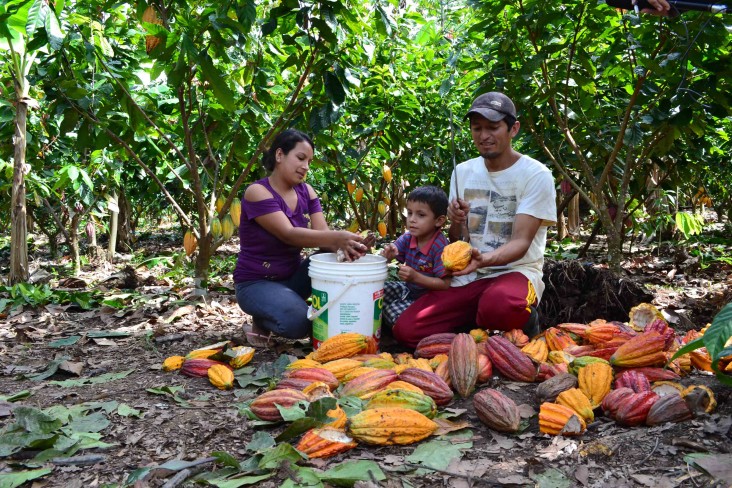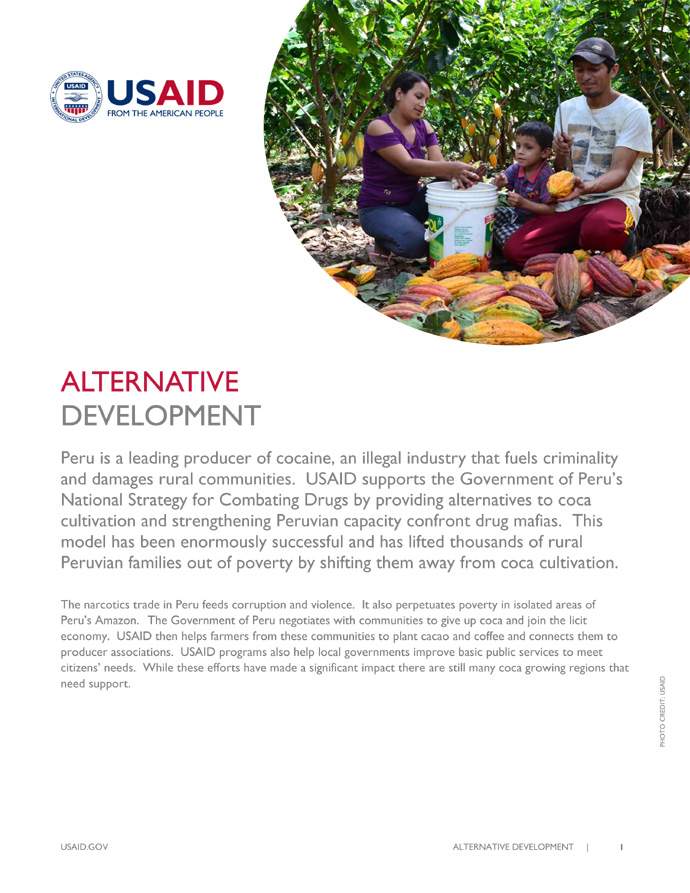
Peru is a leading producer of cocaine, an illegal industry that fuels criminality and damages rural communities. USAID supports the Government of Peru’s National Strategy for Combating Drugs by providing alternatives to coca cultivation and strengthening Peruvian capacity confront drug mafias. This model has been enormously successful and has lifted thousands of rural Peruvian families out of poverty by shifting them away from coca cultivation.
The narcotics trade in Peru feeds corruption and violence. It also perpetuates poverty in isolated areas of Peru’s Amazon. The Government of Peru negotiates with communities to give up coca and join the licit economy. USAID then helps farmers from these communities to plant cacao and coffee and connects them to producer associations. USAID programs also help local governments improve basic public services to meet citizens’ needs. While these efforts have made a significant impact there are still many coca growing regions that need support.
Our Work
DEVELOPING ALTERNATIVE LIVELIHOODS
USAID supports sustainable agroforestry in former coca-producing regions that will lead to legal sources of income through licit crops, such as cacao, coffee, banana, and local timber trees. USAID provides hands-on technical assistance to farmers, including training in modern farming techniques and access to capital to invest in equipment. In 2015 alone, USAID provided assistance to 31,744 families across four regions of Peru to plant 19,000 hectares of cacao and coffee. In communities where alternative development has followed eradication, coca cultivation has been reduced by 90 percent.
Alternative Development ![]() (pdf - 527k)
(pdf - 527k)
Partnering with the Private Sector
Buyers need quality assurance and efficient supply chains to move the products such as cacao and coffee to market. To facilitate this process, USAID partnered with the private sector to strengthen 21 cooperatives and more than 260 small producer groups. Over the last two years, USAID has helped farmers to plant more than 20,000 hectares of high quality “fine and aromatic” cacao. Peru’s national production of high quality, exportable cacao is expected to more than double by 2021. In 2015, USAID leveraged $13.5 million from the private sector to generate $34.0 million in total sales of legal crops and the equivalent of 18,500 full-time jobs. USAID additionally offers a $54 million credit guarantee to banks to encourage lending to farmers and small businesses in target communities.
Facilitating Local Governance
Even when a community successfully transitions from coca production, the pressures to regress to coca persist. To help sustain progress, USAID strengthens local governance by organizing community development committees that create participatory long-term economic development plans. USAID also trains municipal leaders and technicians to improve their budget and project management skills. This training helps communities effectively advocate and request funding for development initiatives. To date, USAID has helped over 300 communities to secure more than $3 million in national-level funds for schools, health services, water, roads and economic opportunities. Most importantly, community members and officials have begun to cooperate to achieve common goals and to sustain the shared commitment necessary to reject illicit coca cultivation.
BUILDING CAPACITY
While USAID has improved the livelihoods of thousands of rural families, there are thousands more that need assistance. Through the National Commission for Development and Life without Drugs (DEVIDA), the Government of Peru has increasingly taken the lead in alternative development. Since 2013, USAID has provided direct government-to-government assistance to support DEVIDA’s alternative development program in areas such as planting, land titling, and community development. USAID is also working closely with DEVIDA to strengthen monitoring, financial management, and environmental compliance capabilities. DEVIDA’s budget grew from $15 million in 2011 to $38 million year in 2015. According to farmers who have received DEVIDA assistance, these programs are working. Eighty-five percent of beneficiaries in post-eradicated communities stated that “DEVIDA’s interventions will contribute to their community’s development.”
Digital Inclusion
Coca is generally produced in remote rural regions with the lowest internet penetrations rates in Peru. USAID supports online connectivity to help facilitate a transition from illicit coca production to the formal economy. To date, USAID has helped to construct 38 “telecenters” in San Martin, Huánuco and Ucayali. These centers provide internet connectivity to local residents and offer trainings in digital and financial literacy. Since 2012, 6,358 participants were successfully trained in these areas. An additional 4,113 residents have attended teleconferences on improving cacao and coffee production. In 2015, the centers launched a program focused on the financial inclusion of women to reach 5,000 beneficiaries.








Comment
Make a general inquiry or suggest an improvement.